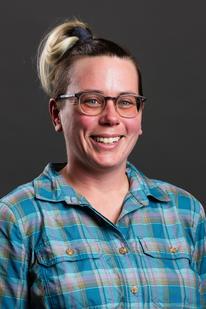Four creeks and their tributaries run through the semi-industrial, up-and-coming neighborhood of Duluth’s Lincoln Park. And as climate change increases the intensity of rainfall events, the chances that the creeks will overflow increases. That could mean flooded basements and other damage to homes and businesses.
Residents can help mitigate some of that water intensity. Green infrastructure like rain gardens, trees and rain barrels can catch the water running off rooftops and keep it from flowing into an overwhelmed creek.

Grant-funded programs to get green infrastructure practices to residents is a great idea. But how that is done is important. For example, a well-intentioned someone or group could get funding to purchase rain barrels. They could hold a public meeting to inform residents about it – those who can will show up, ask a couple questions – and then rain barrels are dropped off.
But things were done differently in Lincoln Park, and for a much bigger reason than just diverting rainwater in one neighborhood. NRRI’s Tiffany Sprague, in her community outreach role, and Minnesota Sea Grant’s Madison Rodman, resilience extension educator, saw a need in their science community to demonstrate best practices for engaging communities in issues like climate change impacts.
“There are a lot of ways to address stormwater impacts, and instead of coming in with one predetermined direction or solution for Lincoln Park, we worked with community members to design a project to meet their needs,” said Rodman. “After hearing and discussing options, they chose a rain-barrel-for-residents effort along with additional education on the city’s responsibility for stormwater and how to connect with city staff.”
They called the collaborative project “One Block at a Time.” And, of course, it had to end with a block party.

“We employed a hyper-local framework to demonstrate how community engagement can be more effective,” said Sprague. “And we saw a need to document how we did it for our colleagues in the resource management, extension educator, science world who are asked to do ‘community engagement’ as part of their grant funding, but are unsure what that looks like.”
So, beyond the rain barrel installations, which is documented in this five-minute video, the team set out to do a deep dive, working alongside the community to understand its current barriers and historical legacies. Then, they captured it all – reports, survey results, tools – to provide continuity for future projects.
“We wanted to take this really good, local-focus theory, with an eye toward equity and reciprocity, and put it into action,” said Sprague. “We hope it provides a good example and helps give others confidence to also do the challenging but good work of on-the-ground engagement.”
Deep Dive
The background assessment was the deep dive on the Lincoln Park community targeted for this rain barrel demonstration effort. What are its unique characteristics? Who lives here? How are their needs met? What’s the history and legacy of the community?
Since water issues were at the heart of the effort for this neighborhood, the team surveyed residents about their flooding concerns. Along with historical information and much more, the team compiled a report, Neighborhood Voices: A Lincoln Park Climate and Water Impacts Survey.
Then, folks were invited to listening and visioning sessions, allowing space for self-reflection and giving the team a better understanding of the climate challenges of the neighborhood. These people became a Community Leadership Team who drove the effort of reaching more neighbors with the block party.
“So hopefully the next person who applies for a grant to work here will be more successful, because they have more than data; they have the voice of Lincoln Park,” said Sprague.
And a major deliverable was the One Block at a Time online toolkit, incorporating the Lincoln Park project with three other community efforts in Indiana and Pennsylvania. It outlines the three-step process – assess, envision, implement – that led to project success for other groups to follow.
“We’re excited to get this out there,” Sprague added. “We’re sharing it with our colleagues in the natural resources community and at conferences. We think it meets a real need.”
Response
After the information sharing, rain barrel situating, data delivering and report writing, what did the Lincoln Park residents think? They wanted more.
“They asked, will there be more rain barrels? Another block party? And I love that. They were really engaged,” Sprague said. “And we hope we’ve made it easier for the next effort in climate resilience for this neighborhood, so they don’t have to start from ground zero in understanding the who and what of Lincoln Park.”
This project was funded by the National Sea Grant program and done in partnership with the City of Duluth, Duluth Superior Area Community Foundation and Ecolibrium3.
